6. EXPLORING THE GALAXY-ABSORPTION CONNECTION
If galactic fountains, chimneys, supershells, cannonballs, or other mechanisms which invoke correlated supernovae explosions to power the outbreak of gas from galactic disks contribute to the replenishment of halo gas, then the QSO absorption line strengths should be correlated to signs of recent star formation. In the chimney model, the gas circulation time is (3-5) x 10^7 yrs (Norman & Ikeuchi 1989). The picture is that ~ 1 kpc superbubbles can be formed if sequential supernovae explosions occur every 10^5 yrs during the 10^7 yr lifetime of a giant molecular cloud (Tomisaka, Habe, and Ikeuchi 1981). The cooling time of the gas is ~ 10^6 yrs at densities of 10^-2 cm^-3. From these sequential supernovae explosions, chimneys can form with cool dense walls of neutral gas and central outward flows of hot gas (T ~ 3 x 10^7 K at the chimney base), which cool due to adiabatic losses and then finally by radiative losses as it rises to the top of the halo. The chimneys trace the spiral arms, and will be on the order of thousands in number for a given galaxy. The OB star formation regions (knots in spiral arms) should be detectable in intermediate redshift HST images. Perhaps there is a correlation between the number of OB associations and the strength of absorption or the detailed kinematic structure inferred from the QSO absorption lines. Additionally, color indices for known morphological types can be used to look for evidence suggestive of star formation in these galaxies, which can then be compared to the absorption line strengths.
Presently, no significant trend of equivalent width with star formation rate has been found; that is not to say there is no connection, but the numbers are much too small statistically (since small impact parameters and large equivalent widths are actually quite rare) to make any trend show up as significant. One thing that is known, is that massive galaxies with high star formation rates are very rare, and the bluest galaxies (highest "specific" star formation rates) tend to be the smallest, as determined from the K-band light. So most of the blue absorbers cannot be Sb's (the average Mg II absorber color) with high star formation rates. It is possible that with detailed information on individual systems something might come out of all this, but nothing statistical has emerged at the present time because of the presently small numbers (Steidel, private communication).
6.1 EXECUTIVE SUMMARY
We present HIRES/Keck spectra having resolution ~ 6 km/s of Mg II 2796 absorption profiles which arise in the gas believed to be associated with 15 identified galaxies over the redshift range (0.5 < z < 0.9). These galaxies have measured redshifts consistent with those seen in absorption. Using non-parametric rank correlation tests, we searched for correlations of the absorption strengths, saturation, and line-of-sight kinematics with the galaxy redshifts, rest frame B and K luminosities, rest B-K colors, and impact parameters D. We found no correlations at the 2.5-sigma level between the measured absorption properties and galaxy properties. Of primary significance is the fact that the QSO-galaxy impact parameter apparently does not provide the primary distinguishing factor by which absorption properties can be characterized. The absorption properties of Mg II selected galaxies exhibit a large scatter, which, we argue, is suggestive of a picture in which the gas in galaxies arises from a variety of on-going dynamical events. Inferences from our study include: (1) The spatial distribution of absorbing gas in and around galaxies does not appear to follow a simple galactocentric functional dependence, since the gas distribution is probably highly structured. (2) A single systematic kinematic model apparently cannot describe the observed velocity spreads in the absorbing gas. It is more likely that galaxy/halo events giving rise to absorbing gas each exhibit their own systematic kinematics, so that a heterogeneous population of sub-galaxy scale structures are giving rise to the observed cloud velocities. (3) The absorbing gas spatial distribution and overall kinematics may depend upon gas producing events and mechanisms that are recent to the epoch at which the absorption is observed. In any given galaxy, these distributions likely change over a ~ few Gyr timescale (few dynamical times of the absorbing clouds), which provides one source for the observed scatter in the absorption properties. Based upon these inferences, we note that any evolution in the absorption gas properties over the wider redshift range (0.4 < z < 2.2) should be directly quantifiable from a larger dataset of high-resolution absorption profiles.
6.2 INTRODUCTION
The Mg II doublet, as seen in absorption in the spectra of background QSOs (e.g. SS92), is known to arise in the low ionization gas associated with a population of "normal" field galaxies that exhibit little to no evolution in their rest frame B-K colors since a redshift of z ~ 1.0 (SDP). Galaxies selected by the known presence of Mg II absorption represent a wide range of colors, from late-type spirals to the reddest ellipticals, have L_B and L_K luminosity functions consistent with local luminosity functions in which morphological types later then Sd are excluded, and exhibit a strong correlation between color and L_K (fainter galaxies are bluer). These facts suggests that a wide range of morphological types are undergoing the processes that give rise to Mg II absorbing gas, but that isolated low mass (L_K < 0.07L*) "faint blue galaxies" are not.
Now that we have a first look at what types of galaxies are being selected by their Mg II absorption cross section, we can undertake studies from which we hope to infer the spatial distribution and line-of-sight kinematics of the absorbing gas and to examine connections, if any, between the absorbing gas and galaxy properties. If correlations between galaxy and absorption properties can be established, where galaxies are directly accessible to imaging and spectroscopy, then we may be able to infer the properties of higher redshift galaxies simply by classifying their absorption properties. The hope is that we may chart the general evolution of galaxies and of their gas kinematic, chemical, and ionization conditions back to the epoch of the earliest QSOs (e.g. Steidel 1993a; Bergeron et al. 1994).
A more direct motive for this study is to examine the model of z < 1 galaxy halos suggested by Lanzetta & Bowen (1990, 1992). They suggested that intermediate redshift galactic halos are roughly identical, have absorbing gas spatial number density distributions ~ r^(1-2), and likely exhibit systematic rotational or radial flow kinematics. The primary test for this picture is the prediction that the observed differences in the absorption properties from one system to another are predominantly due to the QSO-galaxy impact parameter.
Based upon several studies (Petitjean & Bergeron 1990; Bergeron & Boisse' 1991; Lanzetta 1992; Le Brun et al. 1993; Steidel 1993b; Bowen, Blades, & Pettini 1995; Steidel 1995), a consensus has emerged in which the "galaxy/halo" model (first proposed by (Bahcall & Spitzer 1969) is favored over the "galactic fragments" (e.g. Yanny 1992) and "dwarf satellites" (York et al. 1996) models. Whatever the true nature of Mg II absorbing gas, the bottom line is that a relatively luminous galaxy within ~ 40 kpc of the QSO line of sight appears to be a prerequisite for the detection of Mg II absorption (Steidel 1995). If all scenarios contribute at some level, statistical correlations between absorption and galaxy properties predicted by the galaxy/halo model (Lanzetta & Bowen 1992; Lanzetta 1992; Charlton & Churchill 1996) would be "diluted" by the more stochastic kinematics expected from merging dwarf satellite galaxies or accreting gaseous sub-galactic fragments. That is, if the local environments around Mg II absorbing galaxies are populated by satellite galaxies and by fragments of on-going galaxy/halo events (i.e. accretion, superbubbles, merging), systematic trends with impact parameter, or any other galaxy property, would be difficult to detect due to a large scatter in the absorption properties.
In this paper, we report on observations of the Mg II 2796 absorption line obtained with a resolution of ~ 6 km/s and signal-to-noise ratios ~ 30, and explore correlations between the absorption properties and the IR/optical luminosities and colors, impact parameters, and redshifts of the identified associated galaxies.
6.3 OBSERVATIONS
We observed the 11 QSOs presented in Table 6.1 with the HIRES echelle spectrometer (Vogt et al. 1994) on the Keck 10-m telescope on 1995 January 23-25. The spectral resolution was 6.6 km/s (R=45,000). There are small gaps in the spectra redward of 5100 A where the free spectral range of the echelle format exceeds the width of the 2048 x 2048 Tektronix CCD. The spectroscopic sample was taken from the absorption line survey of SS92 and was selected on the basis that each absorption system was associated with an imaged galaxy that had been spectroscopically confirmed to have the same redshift as seen in absorption (SDP).
Table 6.1
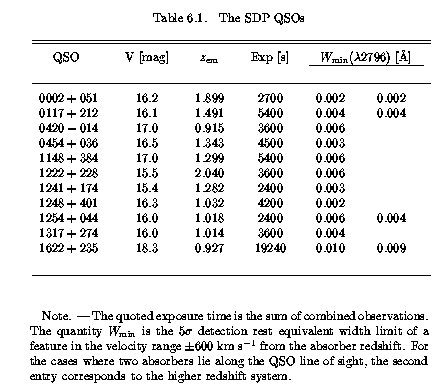
The galaxy properties were obtained from broad-band g(4900/700), R(6930/1500), i(8000/1450) and NICMOS images of the QSO fields. This combination of filters allowed the rest-frame B and K magnitudes of the galaxies to be determined. A brief description of the imaging and follow-up spectroscopic work has been presented by SDP and Steidel & Dickinson (1995). Here, we concentrate on the properties of the 15 identified z < 1 absorbing galaxies for which we have acquired HIRES QSO absorption line spectra.
6.4 ANALYSIS
The HIRES data were reduced with the IRAF (IRAF is distributed by the National Optical Astronomy Observatories, which are operated by AURA, Inc., under contract to the NSF.) Apextract package for echelle data. We have identified absorption features in the spectra using the method presented by Lanzetta, Turnshek, & Wolfe (1987), where we have chosen a bandpass of 2.3 resolution elements (i.e. ~7 pixels). A detection level of 5-sigma was enforced and features having Mg II rest equivalent widths EW(min) < 0.01 A were discarded. This latter criterion enforced a uniform detection level upon all absorption systems at the level of the lowest signal-to-noise ratio spectrum in the sample.
Voigt profiles (natural + thermal broadening) convolved with the
instrumental broadening (Gaussian with sigma = 2.46 km/s) were
fit to the profile substructures using an interactive profile-fitting
algorithm of our own design.
In all cases, the Mg II doublet and at least one unsaturated weaker
transition from either Fe II or Mg I were fit simultaneously.
Thus, in the cases where the Mg II profiles appear saturated, there was
little ambiguity in both the number of subcomponents and their
relative velocities.
In
Figure 6.1,
we present the profile fits to the QSO
absorption lines observed from G2, which is the z = 0.8514 galaxy in
the
In
Figure 6.2,
we present the HIRES Mg II 2796 absorption
profiles in units of rest frame line-of-sight velocity.
The velocity spread of each panel is 400 km/s, except for G2, which
is 800 km/s.
For illustration purposes (to allow a comparison of absorption
strengths and subcomponent variations with the projected galactocentric
distance probed by the line of sight), we have sequenced the profiles
in order of increasing QSO-galaxy impact parameter,
Dh^-1 kpc (We assume q_0 = 0.05 and quote all distances
in terms of h = H_0/100 km/s/Mpc.).
To quantitatively ascertain if any connections between the low
ionization gas absorption strengths and line-of-sight kinematics and
the galaxy properties are present in our sample, we characterized the
profiles by the number of subcomponents, N_cl, or "clouds",
and three simple kinematic indicators.
Since we assume no a priori knowledge of the gas kinematics,
we have developed crude empirical indicators that are model
independent.
The first kinematic indicator is the "absolute deviation from the
median" of the cloud velocities,
where Delv_i = v_i-v, and v is the median cloud
velocity.
The median is used in lieu of the average because the former is
symmetric about the number of clouds and is not sensitive to
one or a few large Delv_i clouds.
The second kinematic indicator is the number of absolute
deviations of the highest velocity cloud,
where Delv^+ and Delv^- are the largest redshifted and
blueshifted cloud velocity differences from the system median,
respectively.
This quantity, which ranges between 1 < N_A < 4 for our data,
measures the degree and presence of an extreme kinematic "outlier"
in each system.
The third kinematic indicator is a measure of the kinematic asymmetry,
where eta = 1 indicates that the extreme redshifted and blueshifted
clouds lie symmetrically about the system median, and small eta
indicates high asymmetry.
We ran non-parametric Spearman and Kendall correlation tests on
the measured galaxy and absorption properties, which are presented in
Table 6.2.
The Kendall tests better handle the treatment of data in which a
value appears multiple times (fractional ranks), as is the case with
N_cl.
Galaxies for which a given property was not measured were excluded
from the test pertaining to the missing property.
Using the criterion P_k < 0.01 (99% probability that
no correlation is not consistent with the data) to indicate the
presence of a correlation, we found no statistically
significant correlations between the absorbing gas strengths or
kinematics with the galaxy properties.
To examine the effects due to projected galactocentric distance, D,
and due to path length through the halo, S = 2 x sqrt(R^2-D^2),
where R = 38h^-1(L/L*)^0.15 (Steidel 1995), we ran
additional tests on the absorption properties versus D/R and S,
and versus L_B and L_K normalized by D and by S.
One might expect correlations to be revealed from the normalized L_K
if absorbing gas exhibited a smooth radial spatial distribution
that scales with the luminosity to some power, as expected for
pressure-confined clouds in halos where the pressure gradient scales
with galaxy mass (Mo & Miralda-Escude' 1996).
Again, we found no correlations.
To investigate sensitivity to small-number statistics, and to
ascertain if our sample of 15 galaxies is a fair representation of the
SDP sample, we also performed Monte-Carlo rank correlation tests.
For each simulation, we assigned the observed absorption properties
(columns 8-13 in
Table 6.2)
to 15 galaxies drawn at
random from 54 z < 1 SDP galaxies.
For each correlation test, 5000 of these simulations were executed and
the probability P_MC that the measured tau_k or greater
would be measured from randomized galaxy-absorption properties for
our sample was computed.
The P_MC strongly correlate with the P_k, which is
indicative that our sample is a representative subset of the SDP data set
and that the measured P_k are reliable indicators.
In
Table 6.3,
we present those tests for which both the simulated and
measured P are weakly suggestive of correlations in that the null
hypothesis (no correlation) is not consistent with the data at the
2-sigma confidence level (P_k < 0.1).
Since one or a few kinematically simple or complex systems could be
dominating a test for which a correlation is suggested at the
~ 2-sigma level, we re-ran the Spearman and Kendall tests on
our sample, each time omitting a single galaxy.
We then examined the distribution of P_k for each test
to see if a large P_k results from the omission of any one
galaxy.
For the correlation tests tabulated in
Table 6.3,
the P_k
distributions cluster tightly about the their respective values,
except for A(Delv) versus S (note the discrepancy between
P_k and P_MC for this case).
We further investigated the "halo" model described by Lanzetta & Bowen
(1990, 1992).
As stated above, the primary test of this model is the prediction that
the observed differences in the absorption properties from one
system to another are predominantly due to the QSO-galaxy impact
parameter.
Thus, we performed maximum likelihood least squares linear fits (LSFs)
to the quantities tested against impact parameter that are listed in
Table 6.3,
The goal is to obtain the significance level of each fitted slope.
If any of these LSF slopes is not inconsistent with zero, within the
uncertainties applied to the data, then we may have further evidence
supportive of a possible correlation.
For the LSF fits, we modeled the uncertainty of each absorption
property as scatter due to Poisson fluctuations, which are predicted
from the fact that the QSO line of sight samples a finite number of
clouds in each galactic system.
For the equivalent widths [see Equation 2 of Lanzetta & Bowen
(1990)], the LSF uncertainty is given by,
where sigma(EW(rest)) is the measured uncertainty in EW(rest)
and the "scatter" term follows from Poisson counting statistics
if the EW(rest) are correlated with N_cl, following EW(rest)
= k x N_cl (Petitjean & Bergeron 1990).
We obtained the LSF relation k=0.0703+/-0.0002 to the data presented
in
Figure 6.3.
The value of k may actually depend upon redshift, but can be
approximated as a constant over 0.5 < z < 0.9, since EW(rest)
and N_cl for our sample do not correlate with redshift, z.
If unresolved sub-components remain hidden in the HIRES profiles, our
measured k would be an upper limit.
A smaller k would result in smaller modeled scatter.
In
Figure 6.4.
we plot the total absorption strength,
EW(rest), verse impact parameter, Dh^-1 kpc.
The solid circles are taken from
Table 6.2,
where the error bars are the modeled scatter as described above.
The open circles are the full z < 1 SDP data set, which we
presented to illustrate that our subsample appears to be a fair
representation of the full available sample.
Applying the modeled scatter as uncertainties in EW(rest), we found
that an LSF to the relation EW(rest) = a x D^alpha yields alpha =
-0.28+/-0.50 with chi^2 = 1.3.
Thus, we found no anti-correlation at the 99.9% confidence level of
EW(rest) with D for our 15 systems.
Apparently, the spatial number density of "halo" absorbing clouds
does not follow a simple power law with galactocentric radius.
For comparison, we also show the LSF fit obtained by Lanzetta & Bowen
(1990) to a similar size but different data set (not shown).
Our LSF fits to DR = alpha x D + A and N_cl = A x D^alpha both
yielded slopes statistically consistent with alpha = 0, where we
have assigned statistical scatter (uncertainties) to DR and N_cl
consistent with those of the EW(rest).
It is important to consider whether non-unique solutions for the
profile fits, as illustrated in
Figure 6.1,
could significantly effect our conclusions.
Consider the number of clouds, N_cl, which is a very central
quantity in that it either directly or indirectly effects the computed
values of the kinematic indicators.
Our fitting philosophy was to introduce the minimum number of
subcomponents that yielded model spectra consistent with the
constraints provided by the error spectra.
Thus, the N_cl are lower limits, since finite signal-to-noise
and instrumental resolution could conceal narrow subcomponents.
The modeled Poisson fluctuations in the N_cl are typically
a factor of a few larger than the uncertainty from the profile fits,
though this is difficult to precisely quantify.
Our results would be altered only if there was some unknown systematic
error in the fitted N_cl with the impact parameter, D, and
if the uncertainty in the fitted N_cl were roughly the
same size as the modeled scatter.
That we have found no dependence of N_cl with D has
implications for predictions from systematic rotational and radial
flow kinematic models.
In particular, consider the median absolute deviation, A(Delv),
versus QSO-galaxy impact parameter, which we have plotted
in
Figure 6.5.
Since the number of clouds is independent of D, we can approximate
A(Delv) ~
Overall, what is clear, is that the absorption properties of Mg II
absorption-selected galaxies exhibit a level of scatter greater than
that predicted by simply assuming Poisson fluctuations on the grounds
that each line of sight is sampling a finite number of clouds.
Based upon 15 systems, we cannot conclude (with confidence) that weak
correlations do or do not exist between the quantified
kinematic properties of the absorbing gas and the galaxy properties
available from ground-based images, but we can argue, based upon the
above discussion, that "smooth" correlations can be ruled out.
Of primary significance is the fact that the QSO-galaxy impact
parameter apparently does not provide the primary distinguishing
factor by which absorption properties can be characterized.
The implications are that (1) the spatial distribution of absorbing gas
surrounding intermediate redshift galaxies is not smoothly varying,
and that (2) the velocities of the absorbing gas clouds cannot be
described by a single systematic kinematic model.
One may infer that these quantities may not be roughly identical
from galaxy to galaxy of similar morphological type, even if the
events and processes that give rise to the gas are.
Such a picture is difficult to reconcile with theoretical results
that predict a "steady state" in which cloud coalescence and growth
from the cooling of hot gas in a virialized halo is balanced by cloud
disruption and evaporation, giving rise to a near unity covering factor
(e.g. Mo & Miralda-Escude 1996; Anninos & Normal 1995;
Begelmann & McKee 1990).
A "steady state" halo of this type would likely show systematic trends
with less scatter than is observed, and is not well supported by
observations of local galaxies (Bowen, Blades, & Pettini 1995), provided
there is no rapid halo evolution from z ~ 0.4 to the present.
If Mg II absorption profiles contain spectroscopic imprints of
systematic spatial and velocity distributions of the low ionization
gas comprising disks and halos, as suggested by Lanzetta & Bowen
(1992), it appears from our results that absorbing gas would have to
arise from a heterogeneous population of events and mechanisms that
each impart their own systematic kinematic signatures, and possibly
chemical and ionization conditions.
From lines of sight through the Milky Way, the Large Magellanic
Cloud (LMC), and local galaxies, a substantial variation in the
absorption properties corresponding to a variety of dynamical events
has been observed (Savage et al. 1993; Lu, Savage, & Sembach 1994;
Sembach, Savage, & Lu 1995;
Bowen, Blades, & Pattini 1995;
Caulet & Newell 1996}).
In the vicinity of a "typical" Mg II absorption-selected galaxy,
such events would need to be on-going over a Hubble time in order to
explain the sustenance of extended gaseous regions [as inferred from
their non-evolving co-moving cross section (SS92)], since the
absorbing cloud lifetimes are ~ 1 Gyr (Lanzetta & Bowen 1990};
Mo & Miralda-Escude' 1996).
Hubble Space Telescope (HST) WFPC2 images of z ~ 1 galaxies from
the DEEP Project reveal a diversity of morphological types, including
small compact galaxies, and apparently normal late-type spirals
(Koo et al. 1996).
These images also reveal evidence suggestive of a higher frequency of
merging in the past and for interactions of small, gas-rich galaxies with
each other or with larger, well-formed galaxies.
Apparently, a mixture of physical processes is at work in the formation
and evolution of field galaxies.
Based upon local studies, Bowen, Blades, and Pettini (1995) have
suggested that recent merging events may play an important role in the
presence of Mg II absorbing gas, and caution against a generalized
halo model.
On the other hand, one cannot completely rule out the idea that some
fraction of the observed systems are dwarfs (i.e. similar to Carina,
Leo I, etc.) that undergo episodic self-regulating star formation,
resulting in the blow out of gas to large radii over a Hubble
time.
Occasionally, a gas rich low mass galaxy could lie within D ~
50 kpc and Delv ~ 100 km/s of an "identified" galaxy by
virtue of projection, especially in the instances when "double
galaxies", which are suggestive of Local Group environments, are seen
to be associated with Mg II and/or C IV absorption.
However, it is difficult to reconcile a large contribution from this
latter picture due to an observed correlation of the absorption
cross-section with the identified galaxy K luminosity (Steidel 1995).
This correlation suggests that galactic mass has some connection
with a galaxy's ability to organize tidally stripped, accreting, or
infalling material (e.g. Mo & Miralda-Escude' 1996; Steidel 1995).
The important point here is that unbiased deep imaging and thorough
spectroscopic surveys of QSO fields are still in progress, and as
shown by Charlton & Churchill (1996b), the simple picture of a
near-unity covering factor "galactic halo" is not yet conclusively
demonstrated.
Even though models of the spatial distributions and kinematics of the
Mg II absorbing gas around galaxies are still not well constrained by
the observations, there is little doubt that the galaxies identified
with Mg II absorption are indeed associated in some way with the
processes that give rise to the absorbing gas (SDP; Steidel 1995).
As such, the types and frequencies of the events that give
rise to absorbing gas are likely to show trends with galaxy
morphologies and impact parameter, even if there is a great deal of
scatter in these trends.
It remains to be understood to what degree extended and warped H I
disks in spiral galaxies contribute to absorption at all impact
parameters (Charlton & Churchill 1996),
though it is highly probable that they
actually dominate for D < 20h^-1 kpc and perhaps can even
account for most strong saturated components out to D <
40h^-1 kpc.
It is interesting to note the extended and complex structure of high
column density H I gas surrounding M81, which is seen to be
distributed in a flattened geometry and is associated with
current satellite mergings (Yun, Ho, & Lo 1994)).
This observation also supports the idea that for r_gal >
20 kpc and for the range of observed morphological types, likely
sources of gas are the tidal stripping of or blow out from orbiting
dwarf satellite galaxies (Wang 1993)), the presence of dwarf
galaxies very close to the QSO line of sight (York et al. 1986), or the
accretion of clumps (fragments) of intergalactic gas
(Mo & Miralda-Escude' 1996).
Since gas producing events (such as superbubbles) from both galaxies
and dwarf companions give rise to similar absorption strengths and
kinematics over a ~ 50 kpc galactocentric range of impact
parameters [as seen for the Milky-Way and environs (Lu, Savage, & Sembach
1994; Caulet & Newell 1996), it will be difficult to interpret
the origins of absorbing gas until deep high-spatial resolution images
of the galaxies can be incorporated into QSO absorption line studies.
Based upon the available data, one may tentatively infer that Mg II
absorption-selected galaxies are roughly identical in the sense that
they are continually processing and accreting gas, but differ in that
the spatial and kinematic distribution of the gas around each
galaxy depends upon the events recent to the epoch at which it is
observed.
It is likely that on-going gas processing events are continuously
reorganizing sub-galaxy distributions of gas on timescales of a few
Gyr.
This is not to imply that global reorganization of gaseous
kinematic, ionization, and spatial distributions occurs in all Mg II
absorbing galaxies.
We caution that the data do not rule out the idea that
sub-galaxy distributions are somewhat stable but have a high level of
structure, since it is possible that observations of a single galaxy
and its surroundings along different lines of sight at a single epoch
in its evolution could give rise to the wide variety of observed
absorption profiles.
A test of these issues would include establishing which, if any, of
the following observed variations in absorption properties show some
type of systematic trend: (1) galaxies of different morphological
types, (2) similar lines of sight through galaxies of a given
morphological type at different cosmic epochs, or (3) different lines
of sight through galaxies of a given morphological type at a given
cosmic epoch.
For example, statistical differences may exist between samples of
profiles for the different morphological types.
This might imply that the relative importance of the various
on-going processes that produce and adjust the distribution of gas is
different in the different morphological types.
Similarly, there could be statistical differences between samples of
profiles for galaxies of the same morphological types at different
redshifts.
This might be indicative that the relative importance of the various
on-going processes is changing.
Since ellipticals and spirals have distinctive internal stellar
dynamics, their gas kinematics may also be distinctive, especially for
r_gal < 20 kpc.
For both ellipticals and spirals, if the events at larger
galactocentric radius arise predominately in satellite galaxies and/or
are stochastic accretion events lasting ~ few Gyr, they will be
observable for the full range of observable D.
Thus, the line-of-sight quantities N_A and eta would be expected
to exhibit scatter with D, since they may be sensitive to the chance
interception of "active" halo material.
As such, inferring the distinction between kinematic systematics based
upon morphological type at small D would be complicated.
It will be an interesting exercise to try to separate out the
absorption properties by galaxy morphology once the number of observed
Mg II absorbing galaxies becomes large.
We are obtaining deep WFPC2 images of the QSO fields with
the goal of obtaining further clues for interpreting the kinematics
measured from HIRES profiles.
In the case of spiral galaxies, inclination and orientation with
respect to the line of sight may play an important role.
It is interesting to compare G7, a face-on spiral, and G15, a highly
inclined spiral, which have comparable L_B luminosities,
N_cl, N_A, and D, but slightly different K luminosities,
and strikingly different absorption profile shapes.
G7 exhibits lower column density clouds that are kinematically
symmetric about the galaxy z direction, whereas G15 exhibits
higher column densities.
The galaxy G2, which is a compact blue diskless galaxy, exhibits
what appears to be a great deal of recent kinematic activity
(see
As a first step toward developing a better appreciation of the
spatial distributions and kinematics of low ionization absorbing gas
associated with galaxies, we have presented the Mg II 2796
absorption profiles for 15 z < 1 galaxies, developed simple
kinematic indicators of the profiles, and searched for statistically
significant correlations between the absorbing gas and galaxy
properties.
Unless the gas kinematics in spiral/disk and elliptical galaxies are
distinguishable as seen in high resolution profiles, it is not likely
the Mg II absorption properties can be used to infer the type of
galaxy associated with the absorbing gas at the highest redshifts,
where the galaxy properties are difficult to obtain.
However, we may be able to roughly infer the region of the galaxy
sampled by the line of sight or something about its current or recent
environmental dynamical activity.
Ultimately, the observed evolutionary properties of gas derived from
QSO absorption line studies are likely to yield direct quantities from
which the formation and evolution time scales of
10^(12-13) M_sun structures in the universe can be better
understood.
Figure 6.1
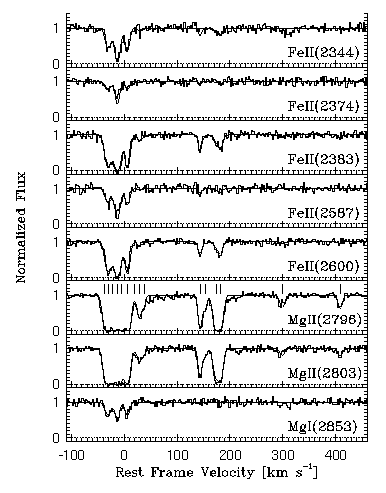
FIG. 6.1 ---
The multiple transitions observed for G2 with simultaneous
profile fits (by hand) shown. The subcomponents from the fit, and their
velocities, are shown as vertical ticks above the Mg II 2796
transition.
Figure 6.2
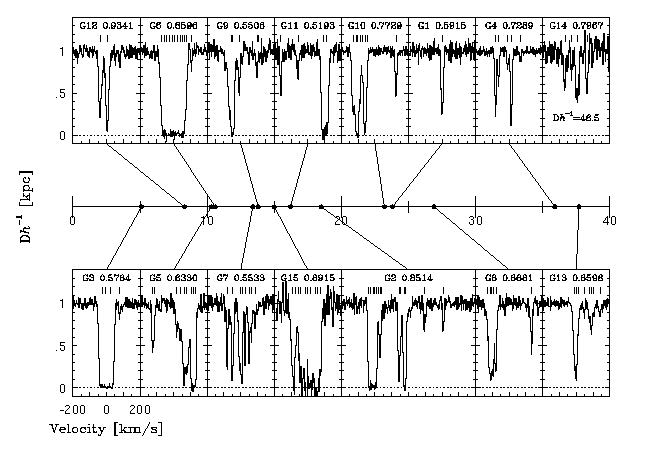
FIG. 6.2 ---
The Mg II 2796 absorption profiles obtained with HIRES on
the Keck telescope plotted in order of increasing impact parameter,
D h^-1 kpc, of the associated absorbing galaxy.
The vertical ticks above the continuum of each absorption feature
mark the subcomponents used in the analysis.



6.5 TESTING FOR CORRELATIONS
Table 6.2
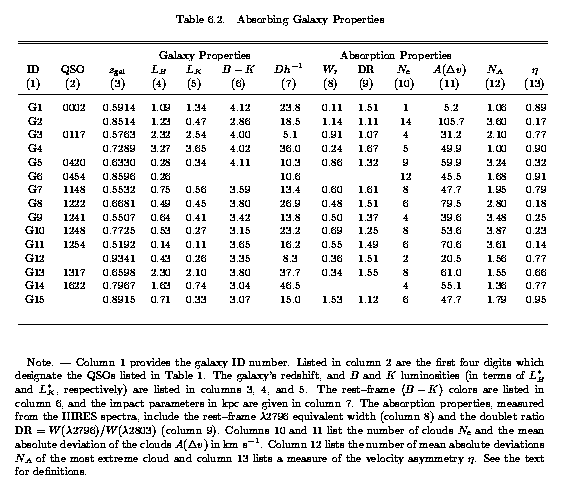
Table 6.3
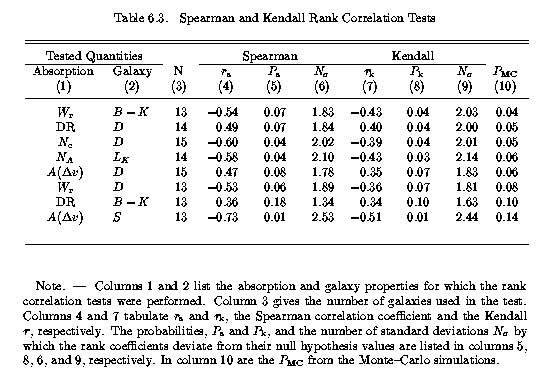
6.6 A SECOND LOOK AT THE GALAXY/HALO MODEL

Figure 6.3
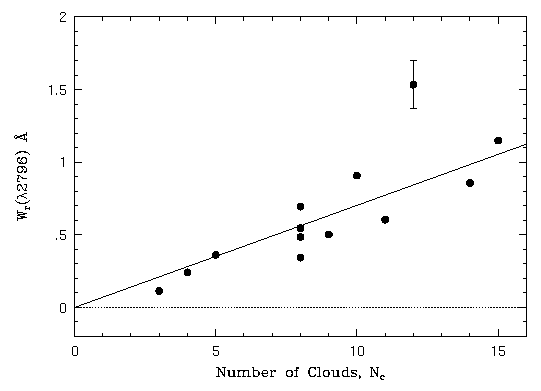
FIG. 6.3 ---
The rest equivalent width of Mg II 2796 versus
the number of clouds for 13 of the systems presented in
Table 6.2.
The error bars are the formal errors from the
spectral analysis and are roughly the size of the data points, with
the exception of that measured for G15. The LSF slope has been forced
through the origin.
Figure 6.4
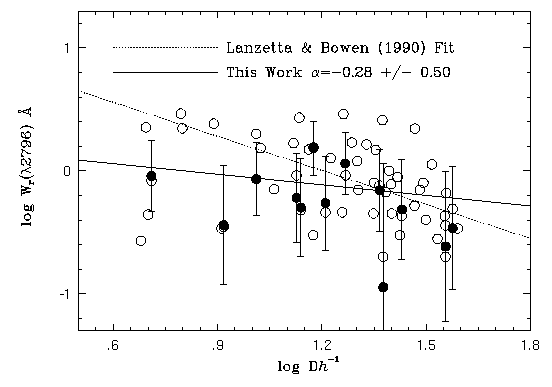
FIG. 6.4 ---
$W_{\rm r}(\lambda 2796)$ versus the QSO--galaxy impact parameter
$D$. The open circles are the $z\leq 1$ SDP dataset and the filled
circles are the 13 systems measured in this work.
The error bars are the modeled scatter in the $W_{\rm r}$ due to
intercepting a finite number of clouds along the line of sight.
The dashed line shows the LSF slope to the assumed relationship $W_{r} =
AD^{\alpha}$ found by Lanzetta \& Bowen (1990) using a smaller and
different data set of {\MgII} absorbers. The solid line is our LSF result.
We found $\alpha = -0.28\pm 0.50$, which is not a statistically
significant slope.
Figure 6.5

FIG. 6.5 ---
The median absolute deviation of cloud velocities versus
the QSO-galaxy impact parameter. There is no clear trend in the
line-of-sight velocity "dispersion" with the projected galactocentric
distance probed by the QSO light path. Both the rotational and infall
kinematic models of galactic halos predict a decreasing spread with
impact parameter (see text).
6.7 DISCUSSION
6.8 CONCLUSION
A more comprehensive appreciation of the spatial and kinematic
properties of low ionization absorbing will require a sizable unbiased
sample of high resolution absorption profiles (unbiased in that the
distribution of galaxy luminosities, colors, impact parameters, and
absorption rest equivalent widths are consistent with having been
drawn from the observed distributions of Mg II selected galaxies).
It is important that surveys of QSO fields be complete to a small
limiting rest frame luminosity and that the selection of these fields
be unbiased with regard to the presence or non-presence of
intervening absorbing galaxies.